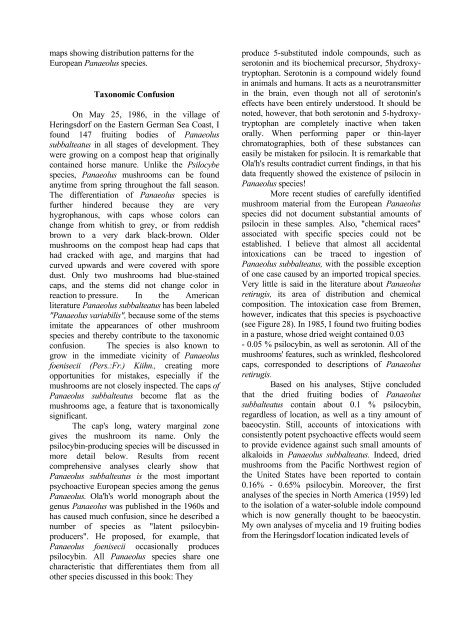Jochen Gartz - Magic Mushrooms Around the ... - preterhuman.net
Jochen Gartz - Magic Mushrooms Around the ... - preterhuman.net
Jochen Gartz - Magic Mushrooms Around the ... - preterhuman.net
You also want an ePaper? Increase the reach of your titles
YUMPU automatically turns print PDFs into web optimized ePapers that Google loves.
maps showing distribution patterns for <strong>the</strong><br />
European Panaeolus species.<br />
Taxonomic Confusion<br />
On May 25, 1986, in <strong>the</strong> village of<br />
Heringsdorf on <strong>the</strong> Eastern German Sea Coast, I<br />
found 147 fruiting bodies of Panaeolus<br />
subbalteatus in all stages of development. They<br />
were growing on a compost heap that originally<br />
contained horse manure. Unlike <strong>the</strong> Psilocybe<br />
species, Panaeolus mushrooms can be found<br />
anytime from spring throughout <strong>the</strong> fall season.<br />
The differentiation of Panaeolus species is<br />
fur<strong>the</strong>r hindered because <strong>the</strong>y are very<br />
hygrophanous, with caps whose colors can<br />
change from whitish to grey, or from reddish<br />
brown to a very dark black-brown. Older<br />
mushrooms on <strong>the</strong> compost heap had caps that<br />
had cracked with age, and margins that had<br />
curved upwards and were covered with spore<br />
dust. Only two mushrooms had blue-stained<br />
caps, and <strong>the</strong> stems did not change color in<br />
reaction to pressure. In <strong>the</strong> American<br />
literature Panaeolus subbalteatus has been labeled<br />
"Panaeolus variabilis", because some of <strong>the</strong> stems<br />
imitate <strong>the</strong> appearances of o<strong>the</strong>r mushroom<br />
species and <strong>the</strong>reby contribute to <strong>the</strong> taxonomic<br />
confusion. The species is also known to<br />
grow in <strong>the</strong> immediate vicinity of Panaeolus<br />
foenisecii (Pers.:Fr.) Kiihn., creating more<br />
opportunities for mistakes, especially if <strong>the</strong><br />
mushrooms are not closely inspected. The caps of<br />
Panaeolus subbalteatus become flat as <strong>the</strong><br />
mushrooms age, a feature that is taxonomically<br />
significant.<br />
The cap's long, watery marginal zone<br />
gives <strong>the</strong> mushroom its name. Only <strong>the</strong><br />
psilocybin-producing species will be discussed in<br />
more detail below. Results from recent<br />
comprehensive analyses clearly show that<br />
Panaeolus subbalteatus is <strong>the</strong> most important<br />
psychoactive European species among <strong>the</strong> genus<br />
Panaeolus. Ola'h's world monograph about <strong>the</strong><br />
genus Panaeolus was published in <strong>the</strong> 1960s and<br />
has caused much confusion, since he described a<br />
number of species as "latent psilocybinproducers".<br />
He proposed, for example, that<br />
Panaeolus foenisecii occasionally produces<br />
psilocybin. All Panaeolus species share one<br />
characteristic that differentiates <strong>the</strong>m from all<br />
o<strong>the</strong>r species discussed in this book: They<br />
produce 5-substituted indole compounds, such as<br />
serotonin and its biochemical precursor, 5hydroxytryptophan.<br />
Serotonin is a compound widely found<br />
in animals and humans. It acts as a neurotransmitter<br />
in <strong>the</strong> brain, even though not all of serotonin's<br />
effects have been entirely understood. It should be<br />
noted, however, that both serotonin and 5-hydroxytryptophan<br />
are completely inactive when taken<br />
orally. When performing paper or thin-layer<br />
chromatographies, both of <strong>the</strong>se substances can<br />
easily be mistaken for psilocin. It is remarkable that<br />
Ola'h's results contradict current findings, in that his<br />
data frequently showed <strong>the</strong> existence of psilocin in<br />
Panaeolus species!<br />
More recent studies of carefully identified<br />
mushroom material from <strong>the</strong> European Panaeolus<br />
species did not document substantial amounts of<br />
psilocin in <strong>the</strong>se samples. Also, "chemical races"<br />
associated with specific species could not be<br />
established. I believe that almost all accidental<br />
intoxications can be traced to ingestion of<br />
Panaeolus subbalteatus, with <strong>the</strong> possible exception<br />
of one case caused by an imported tropical species.<br />
Very little is said in <strong>the</strong> literature about Panaeolus<br />
retirugis, its area of distribution and chemical<br />
composition. The intoxication case from Bremen,<br />
however, indicates that this species is psychoactive<br />
(see Figure 28). In 1985, I found two fruiting bodies<br />
in a pasture, whose dried weight contained 0.03<br />
- 0.05 % psilocybin, as well as serotonin. All of <strong>the</strong><br />
mushrooms' features, such as wrinkled, fleshcolored<br />
caps, corresponded to descriptions of Panaeolus<br />
retirugis.<br />
Based on his analyses, Stijve concluded<br />
that <strong>the</strong> dried fruiting bodies of Panaeolus<br />
subbalteatus contain about 0.1 % psilocybin,<br />
regardless of location, as well as a tiny amount of<br />
baeocystin. Still, accounts of intoxications with<br />
consistently potent psychoactive effects would seem<br />
to provide evidence against such small amounts of<br />
alkaloids in Panaeolus subbalteatus. Indeed, dried<br />
mushrooms from <strong>the</strong> Pacific Northwest region of<br />
<strong>the</strong> United States have been reported to contain<br />
0.16% - 0.65% psilocybin. Moreover, <strong>the</strong> first<br />
analyses of <strong>the</strong> species in North America (1959) led<br />
to <strong>the</strong> isolation of a water-soluble indole compound<br />
which is now generally thought to be baeocystin.<br />
My own analyses of mycelia and 19 fruiting bodies<br />
from <strong>the</strong> Heringsdorf location indicated levels of








![The Big Lie 9-11 and Government Complicity in Mass Murder [PDF]](https://img.yumpu.com/50957077/1/190x245/the-big-lie-9-11-and-government-complicity-in-mass-murder-pdf.jpg?quality=85)








